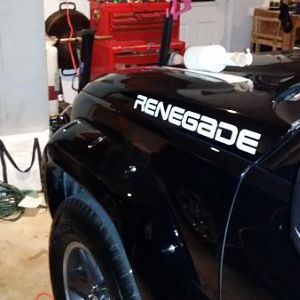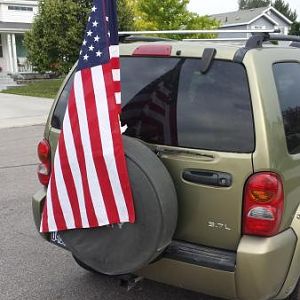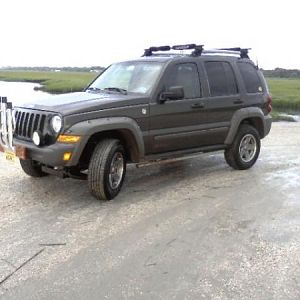TwoBobsKJ
Full Access Member
So my '03 started with a very mild internal tapping noise last summer that would come and go. But just before Christmas it transitioned to a definite knock that only got worse. Three weeks ago it got so bad that listening to the radio was a waste and my neighbors could hear me coming. Since I'd already found a donor engine, and I had very important customer visits that required I get this done, I decided I'd do the swap even though it was COLD around here at the time. Thankfully the garage has a heater that came in very handy.
Here's why it was past time to replace my original engine:
Found an '07 engine from a Dodge Dakota with only 9700 miles. Some topside damage - broken upper radiator neck, power steering pump and the plastic valve cover was broken. Other than those broken parts though, it is exceptionally clean and mechanically sound. With the exception of the valve cover and the timing cover the broken parts had to be swapped out for those on the original engine.
Side view:
So if you have an '03 or '04 Liberty and you want to swap in an engine from an '05 or newer (even up to a 2012) here are external components you'll need from your original engine (same components from new engine will likely be different):
Internally, the right side cam sprocket and crankshaft reluctor ring must match your computer. The '02 through '04 use the JTEC computer; '05 and later use the NGC computer, so you have two options. One, pull the cam sprocket and reluctor ring from your original engine and then break down the donor and install the originals in the donor. That means you're tearing down two engines- that's a lot of work. So I purchased a cam sprocket, reluctor ring and EGR blocking plate from Engine-Guru.com so that I only needed to break down the new engine instead of both of them.
Here's the reluctor ring for the crankshaft (1st pic) and the cam sprocket in the 2nd pic. You'll probably need to get three new T-27 screws for the reluctor ring (I did) and they're dealer-only (about $1.25 each); the screws were installed at the factory with thread lock so it's easy to strip out the screw heads. I didn't take a pic of the EGR blocking plate (new engines have an external EGR valve that your older engine doesn't have) but it's a simple 1/4" steel plate in the shape of the valve:
If we only needed to swap out the cam sprocket we'd just take off the timing cover to remove the timing chains. But we also need to swap out the reluctor ring which is attached to the rear portion of the crankshaft - so the crank has to be removed. The 3.7 has a two-piece block, so the lower section - the bedplate - must be taken off to remove the crank. So that means the main bearings and bearing caps for each of the connecting rods is taken off to get the crank out. Get a copy of the Factory Service Manual for detailed instructions, torque specs, etc. to learn how to do both procedures. It looks intimidating at first but take it step-by-step and you'll be fine. One note: Some folks on other forums have had to remove the pilot bearing on the end of the crank so the nose of the torque converter will fit. I did NOT have to do that but compare the size of the opening in the end if your original crank with the donor motor's crank. If the pilot bearing has to be removed so your torque converter will fit you may need to take the crank to a machine shop. That bearing is pressed in very tightly and won't come out with a pilot bearing puller.
Timing chains (new engine - nice and clean):
Bedplate and crankshaft removed:
IMPORTANT!! The connecting rods use "torque to yield" (TTY) bolts and MUST NOT be reused. They are not easy to find (not available at standard parts stores) and have to be ordered through the dealership. They cost me $1.20 each plus $4 shipping from a dealership in central Ohio - plan ahead on that one.
The timing cover is the same on 3.7 blocks through at least 2010 so you don't have to replace that (I used the cover from my original engine due to the accident damage to the donor motor) but when you remove it you will have to install new gaskets. Besides the gaskets for the timing cover, you'll also need gaskets for the water pump, valve covers, intake manifold, exhaust manifolds and oil pan. The front crank main seal gasket comes with the timing cover gasket set so you're good there. But you'll certainly want to replace the rear main seal too if you have to remove the crankshaft to swap the reluctor ring so order one before you get started. The oil pan gasket is also the windage tray. Here's what it looks like:
Once I got the old engine out it was obvious the original motor mounts were shot:
NAPA carries them so I replaced the pair for $80.
One frustration I ran into as I was wrapping things up - the power steering pump wouldn't bolt into the cylinder head! The '07 pump uses different bolt locations than the '03 - however, the bosses are in the correct place to put the '03 pump on the '07 cylinder head. Just have to run a tap into the bosses that are cast on the head. The pic below shows the bosses that need tapped; the other 3 are for the '07 pump bolts. Use an 8M X 1.25 tap; casting sand is all that is in the hole locations in the head so it's an easy 10 minute job.
After using lots of Lucas Assembly Lube on the internal parts - main bearings, all connecting rod bearings and the crankshaft journals - I assembled everything being very careful of torque specs and bolt tightening order. I put on the timing cover, exhaust manifolds and cats and the new engine was ready to go back in.
Filled the engine with all fluids, put on the intake manifold and the accessory components, reattached the wiring, said a quick prayer (!) and turned the key and Bingo! it started right up. Put 1200 miles on it the next five days and it drove like night and day. Obviously the banging/knocking is gone but the old Liberty purrs like a kitten and has a definite power improvement.
The project isn't technically hard but having a comprehensive tool selection is necessary. The most handy tool I used was a 36" ratchet extension I borrowed to get to the transmission bolts at the top of the bellhousing. Would have been a struggle to get to those bolts off and on otherwise. I had a bit of a challenge lining up the flex plate and torque converter bolts but finally got it.
Hope this helps others considering an engine swap. Drop me a PM if you have any questions. :favorites13:
Bob
Here's why it was past time to replace my original engine:
You must be registered for see images
Found an '07 engine from a Dodge Dakota with only 9700 miles. Some topside damage - broken upper radiator neck, power steering pump and the plastic valve cover was broken. Other than those broken parts though, it is exceptionally clean and mechanically sound. With the exception of the valve cover and the timing cover the broken parts had to be swapped out for those on the original engine.
You must be registered for see images attach
Side view:
You must be registered for see images attach
So if you have an '03 or '04 Liberty and you want to swap in an engine from an '05 or newer (even up to a 2012) here are external components you'll need from your original engine (same components from new engine will likely be different):
- Intake manifold
- Oil pan
- AC compressor, alternator, power steering pump, water pump
- Original motor mounts (or new; more on that later)
- Exhaust manifolds
- Oil filler neck
- Oil drip pan (under the oil filter)
Internally, the right side cam sprocket and crankshaft reluctor ring must match your computer. The '02 through '04 use the JTEC computer; '05 and later use the NGC computer, so you have two options. One, pull the cam sprocket and reluctor ring from your original engine and then break down the donor and install the originals in the donor. That means you're tearing down two engines- that's a lot of work. So I purchased a cam sprocket, reluctor ring and EGR blocking plate from Engine-Guru.com so that I only needed to break down the new engine instead of both of them.
Here's the reluctor ring for the crankshaft (1st pic) and the cam sprocket in the 2nd pic. You'll probably need to get three new T-27 screws for the reluctor ring (I did) and they're dealer-only (about $1.25 each); the screws were installed at the factory with thread lock so it's easy to strip out the screw heads. I didn't take a pic of the EGR blocking plate (new engines have an external EGR valve that your older engine doesn't have) but it's a simple 1/4" steel plate in the shape of the valve:
You must be registered for see images
You must be registered for see images attach
If we only needed to swap out the cam sprocket we'd just take off the timing cover to remove the timing chains. But we also need to swap out the reluctor ring which is attached to the rear portion of the crankshaft - so the crank has to be removed. The 3.7 has a two-piece block, so the lower section - the bedplate - must be taken off to remove the crank. So that means the main bearings and bearing caps for each of the connecting rods is taken off to get the crank out. Get a copy of the Factory Service Manual for detailed instructions, torque specs, etc. to learn how to do both procedures. It looks intimidating at first but take it step-by-step and you'll be fine. One note: Some folks on other forums have had to remove the pilot bearing on the end of the crank so the nose of the torque converter will fit. I did NOT have to do that but compare the size of the opening in the end if your original crank with the donor motor's crank. If the pilot bearing has to be removed so your torque converter will fit you may need to take the crank to a machine shop. That bearing is pressed in very tightly and won't come out with a pilot bearing puller.
Timing chains (new engine - nice and clean):
You must be registered for see images attach
Bedplate and crankshaft removed:
You must be registered for see images attach
IMPORTANT!! The connecting rods use "torque to yield" (TTY) bolts and MUST NOT be reused. They are not easy to find (not available at standard parts stores) and have to be ordered through the dealership. They cost me $1.20 each plus $4 shipping from a dealership in central Ohio - plan ahead on that one.
The timing cover is the same on 3.7 blocks through at least 2010 so you don't have to replace that (I used the cover from my original engine due to the accident damage to the donor motor) but when you remove it you will have to install new gaskets. Besides the gaskets for the timing cover, you'll also need gaskets for the water pump, valve covers, intake manifold, exhaust manifolds and oil pan. The front crank main seal gasket comes with the timing cover gasket set so you're good there. But you'll certainly want to replace the rear main seal too if you have to remove the crankshaft to swap the reluctor ring so order one before you get started. The oil pan gasket is also the windage tray. Here's what it looks like:
You must be registered for see images attach
Once I got the old engine out it was obvious the original motor mounts were shot:
You must be registered for see images
NAPA carries them so I replaced the pair for $80.
One frustration I ran into as I was wrapping things up - the power steering pump wouldn't bolt into the cylinder head! The '07 pump uses different bolt locations than the '03 - however, the bosses are in the correct place to put the '03 pump on the '07 cylinder head. Just have to run a tap into the bosses that are cast on the head. The pic below shows the bosses that need tapped; the other 3 are for the '07 pump bolts. Use an 8M X 1.25 tap; casting sand is all that is in the hole locations in the head so it's an easy 10 minute job.
You must be registered for see images
After using lots of Lucas Assembly Lube on the internal parts - main bearings, all connecting rod bearings and the crankshaft journals - I assembled everything being very careful of torque specs and bolt tightening order. I put on the timing cover, exhaust manifolds and cats and the new engine was ready to go back in.
You must be registered for see images attach
Filled the engine with all fluids, put on the intake manifold and the accessory components, reattached the wiring, said a quick prayer (!) and turned the key and Bingo! it started right up. Put 1200 miles on it the next five days and it drove like night and day. Obviously the banging/knocking is gone but the old Liberty purrs like a kitten and has a definite power improvement.
The project isn't technically hard but having a comprehensive tool selection is necessary. The most handy tool I used was a 36" ratchet extension I borrowed to get to the transmission bolts at the top of the bellhousing. Would have been a struggle to get to those bolts off and on otherwise. I had a bit of a challenge lining up the flex plate and torque converter bolts but finally got it.
Hope this helps others considering an engine swap. Drop me a PM if you have any questions. :favorites13:
Bob
Last edited:










